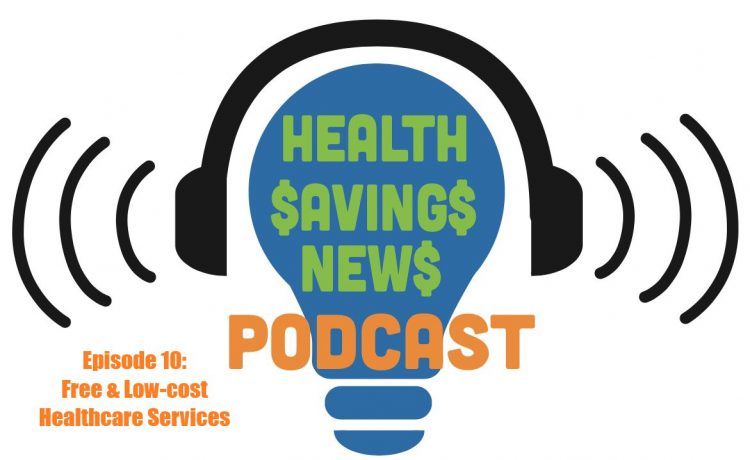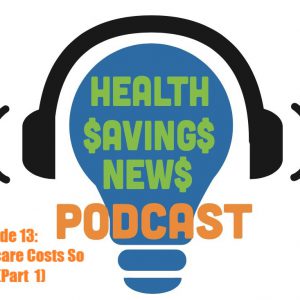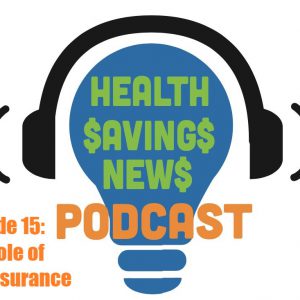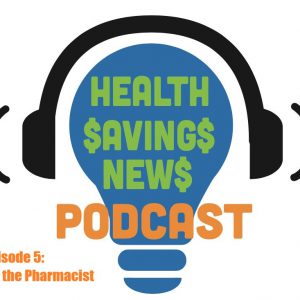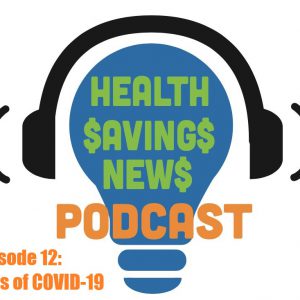Note: This is a rough transcript of episode 10 of Health Savings News and has been lightly edited for clarity. Copy may not be in its final form.
[Fundraising appeal]
Evan (00:00):
Health Savings News is brought to you by NeedyMeds. Ever since NeedyMeds was founded 25 years ago, all the information on the website has been free. In the beginning there were only two part-time employees; now we have a staff of 30. When we started, we only had information on pharmaceutical patient assistance programs; now we have information on 40,000 programs covering over a dozen different types of assistance. We’ve gone from having a hundred visitors a day to the website to 10-15,000 hits now.
In the past, we have been able to cover our operating costs, but this year has been different. We’ve experienced some unexpected expenses. Due to our host going out of business, it became necessary for us to update our entire data system and website. This update will give our site visitors a much needed comprehensive search experience as a result for the first time, our 25 year history, we are facing an operational deficit in 2022. NeedyMeds has always strived to pay a living wage, and we have not had to lay anybody off during the pandemic. We are asking for your help to help us continue what we do as well as adding to the information that we provide. We have big plans for the future, but to accomplish them we need your help. Please consider making a donation at needymeds.org.
You can also check our blog at blog.needymeds.org for transcripts of all of our podcasts. Recent blogs include an entry observing National Immunization Month which just ended in August, as well as a blog for National Health Center Week, which — while over — is relevant to today’s episode topic. Thank you again for listening.
[intro music]
Evan (02:04):
Hello, and welcome to Health Savings News: the podcast about healthcare costs in America and how to save money on the often expensive care all kinds of people need. I’m your host, Evan O’Connor, joined by retired doctors, Rich Sagall and Mike Woods. Each episode we discuss healthcare costs in America, offer tips for saving money, and relevant news that affects and reflects the expensive landscape of healthcare in America. Today’s topic is free clinics and other low cost healthcare options. As healthcare has become more and more expensive, the need for low cost healthcare has increased. Many people living in more rural parts of the country have a very limited number of options to see a doctor and depending on their insurance status, the number of available in-network doctors can be even lower. Many people do not regularly see their doctor, only seeking healthcare when a more serious condition arises. It can be a stressful situation to be uninsured and have an unforeseen medical problem come up, especially during the ongoing pandemic. We’ve mentioned before that NeedyMeds has information on tens of thousands of free, low cost, and sliding-scale clinics to offer a wide variety of healthcare services.
Rich (03:05):
Long ago, when we had first started NeedyMeds, we would get calls from people who said, “My medicine is on the PAP (Patient Assistance Programs), I meet all the qualifications, but I can’t afford to see a doctor, so I can’t get the prescription, so I can’t apply.” They wanted me as a physician to write their script. Obviously I couldn’t do that since they weren’t patients of mine. So that’s why we started the free, low-cost, sliding scale database. It’s grown over time and now contains over 19,000 clinics. What we’re going to do is discuss some of the different types of clinics, the services they provide, and how you can access this medical care. Mike, you wanna start?
Mike (03:40):
Yeah, I was gonna say, we’ve already told you how to save money and prescriptions and by, you know, shopping around and staying healthy. But today is devoted to the low cost options for medical care.
Rich (03:51):
There are many different types of clinics, and Mike’s gonna talk about a few of the different ones.
Mike (03:56):
But when we start saying that there are many ways that you can take advantage of low cost options. The most common one is specific locations like these low cost clinics or making arrangements with providers for low cost medical care. Low cost options can also include telemedicine, remote monitoring, financial aid to help with the medical expenses, borrowing or buying reduced cost medical equipment. Let’s start however, with the low cost clinics. And just remember a lot of this — although it sounds like it may be for those without health insurance — if you do have high co has on your insurance a lot of this information is valuable to you as well.
Rich (04:41):
I should mention before you get started, Mike, that we only list clinics that do offer a free, low-cost, or sliding-scale services. There are many clinics that are excellent and provide excellent services, but we don’t include them because they don’t adjust their fees. I should also mention that if you have a private physician, you may want to talk to him or her. Some of them will take into account your financial situation or come up with payment plans.
Mike (05:07):
Yes, it’s actually a program that some offer is called direct primary care providers, where they actually will have an arrangement between you and the provider to provide you a certain level of medical care for a certain price. Mainly this just involves preventive care and not specialist visits or sick visits. But it is worth asking your provider if they will do that, or even searching for providers who do offer that option.
Rich (05:38):
One other thing we should clarify before we get into the different types of clinics is the different types of providers. Besides physicians, there are nurse practitioners and physician assistants. These categories of health providers run many clinics, particularly in rural areas. Their training is not as extensive as physicians, but they treat many, many types of medical problems.
Mike (06:00):
And for the most part, you’ll find that their fees are much less. So sometimes seeking out one of these providers will be much less expensive for you.
Rich (06:09):
And they’re often grouped together and called mid-level providers.
Mike (06:13):
There are a few general recommendations that we would like to make as overall things you should think about. Number one is we’ve talked about this before with other things, but shop around. Not all clinics will charge the same price, so it’s sometimes in your best interest to look around and find the lowest price clinic. The biggest thing that you can do to save money in medical costs is to avoid emergency rooms at all costs, unless your situation is urgent or truly life threatening. Regular care at emergency room is sometimes a hundred times greater than the cost of a clinic visit. And our final overall recommendation is log onto NeedyMeds. We have all the information you could possibly need on looking up locations for low cost and sliding scale clinics.
Rich (07:07):
Mike is right on that. On the homepage, if you go to the healthcare savings tab, you can find the free, low-cost, sliding-scale clinics. And we do divide them up somewhat into dental clinics, medical clinics, mental health, and substance use disorder. But these clinics provide many, many other services and we try to list them all for each clinic.
Mike (07:24):
A lot of the clinics are based on income, insurance, and health status. And a lot of these clinics are state and federally funded, but the biggest advantage for patients is that they cannot turn patients away. You can be seen no matter what your insured status or ability to pay. So, and the good news is that a lot of these clinics involve almost all of the services you might need. This can include general primary care, prenatal care, infant care, infant immunizations, prescription drugs, dental care, and in some cases even specialized care for some serious chronic conditions like substance abuse and HIV/AIDS.
Rich (08:09):
Our goal is to list every clinic available. And as I said, we have over 19,000 of them with as much information as we can get. Some of the services available many people may not be aware of. I know from my experience in public health many public health departments offer immunizations for people that can’t afford them, including expensive ones, such as shingles. They may have a well baby clinic, visiting nurse for newborns, and other services. So it does pay to check your help with your local health department and see what they offer.
Mike (08:39):
Each clinic will vary a lot and some of them will have specific income requirements to allow you to have a low or sliding scale cost for the visit. It will vary by state as well. And you will just need to have to– you will just need to look into the individual clinic to find out what their criteria are.
Rich (09:01):
When we talk about clinics, we want to remind people that the physicians working there generally have the same training as private care physicians and the service you can get is excellent in many of the clinics. Mike’s gonna talk about some of the different types such as the state, federal trainings, clinics, et cetera.
Mike (09:20):
One of the recommendations if one of these is available to you is: many people live close to a teaching hospital or medical center. Most of these will provide free or low cost care for any patients. Now, the two drawbacks of these clinics are number one, a lot of times you’ll be seen primarily by residents who are less experienced providers and because they are still learning the trade so to speak the visits are longer. However they are usually monitored by an attending physician so that the quality of care is maintained. The other restriction is obviously you need to be living near a large city or other location that does have one of these large teaching hospitals or medical centers. A lot of times your local hospitals will also have a medical center where you can either negotiate or obtain a low cost or free healthcare. And it would just require calling your local hospital or medical center to see if they do indeed provide this type of opportunity.
Rich (10:30):
I want to emphasize one point that Mike made that even though if you go to a teaching facility, you may be– your initial encounter may be with a student or resident. You always have another doctor, an experienced physician, looking over their shoulder and monitoring what’s going on. So you really get the care of two doctors for the price of one.
Mike (10:50):
Planned parenthood is another form of low-cost or sliding scale clinic that it’s available to women. And it’s not just for women who are pregnant. They also offer birth control, testing and treatment for sexually transmitted infections, and routine healthcare for women.
Evan (11:09):
I would like to add that Planned Parenthood also does treat men, does treat sexually transmitted infections in men and women. They’re often very accepting healthcare providers for LGBT people, and their intent has always been to help low-income people in need of healthcare.
Mike (11:27):
Well, one thing to also think about from a financial point of view, and again, I don’t know where this will fit, but a lot of times, if your income allows it, you can actually apply for Medicaid. The income limits depend according to your state, but if you qualify, it is an excellent form of insurance that will pay for most, if not all of your medical costs. The current average is for incomes less than 133% of the federal poverty level, and many states have even lower requirements in order to obtain Medicaid in that state.
Rich (12:03):
Another option for healthcare that many people don’t think about are clinical trials. I think that’s worth mentioning. These are trials of new drugs, and if your diagnosis fits one of these trials, you get medications for free. You get regular checkups, you get all sorts of healthcare and no cost. Plus you’re helping study new drugs that may save people’s lives and make their lives more pleasant. So it’s just something to consider. There is a government website that lists them all in. There are many recruiting agencies that are looking for subjects or volunteers for these programs.
Mike (12:36):
Yeah. Most of the time you would consider a clinical trial as something as a last choice if no other treatment options are working, but it is an option. If you cannot otherwise afford medical care, the limitations are that the clinical trials have limited availability. You have to recognize that you are– that you will be getting an untried treatment, possibly getting the placebo or known treatment, and you’ll be exposed to medications whose side effects are unknown. Also, I’ve also read that not all clinical trials will cover the medical care associated with the trial beyond the cost of the medications and the physicians. There’s another consideration when it comes to medical care is specific populations. NeedyMeds has a section that is Diagnosis-Based Assistance programs, which covers this particular thing. But what this is all about is if you have a specific condition, you can find assistance either through organizations that support people with those conditions such as the American Cancer Society or American Diabetes Association. So if you have a specific diagnosis, it is very well worth logging on to NeedyMeds and finding if there’s something like that specific to your diagnosis. Having families with children’s with special needs are also a distinct population, that there are many resources, both medical and financial, that are available for them.
Rich (14:09):
We should also mention telehealth. This is relatively new and has gained popularity because of COVID. And it is a viable option. Sometimes the prices are a lot less expensive than an in than an in-office visit. It’s appropriate for certain types of problems, but others, you really need to have a face-to-face evaluation.
Mike (14:28):
Yeah. As always tell people, you can’t really parse a rash over a video feed. Rashes have to be seen, felt, and looked at closely. You may also find that your own primary care provider will offer you that service through patient portals. You may also be able to access your primary care physician, either through secured email or other ways of sending messages back and forth with them. There are indeed companies that specialize in telemedicine, and it may be that you end up having to do that if you discover that your primary care or other physicians that you know do not offer that service. These telepresence or telemedicine visits also worked very well for online counseling, and during the time of COVID, when a lot of people were not going out that often to see healthcare providers, online counseling was a God sent for a lot of these people with problems that required the counseling. Other ways to save money are hotlines that you can call to have questions answered, to know if you can actually avoid going in for a healthcare visit or not. A lot of primary care practices have an after hours number that you can call to do this as well. A new type of technology is starting to become better utilized, and that’s home monitoring devices. They allow your providers or specialists to pick up problems in the early phases where they can give you a call and adjust something in your care before it becomes a problem. Some of the more common things are blood glucose monitoring, heart rate monitoring for those with irregular heartbeats, high blood pressure monitoring and monitoring for breathing difficulty and low oxygen. Some of this equipment is available at lower cost and the devices that are available can be also found on the NeedyMeds website.
Rich (16:36):
One option you have to be aware of and considered carefully is Dr. Google. In other words, looking up on the web to find the cause of your symptoms, because those programs always look for the most serious type of problem or diagnosis and cause a lot of concern, unnecessary concern and heartache. You really wanna talk to a trained professional who knows what they’re doing.
Mike (17:02):
I think one of the last things to consider when you’re talking about low-cost medical care is sources of financial aid. So we’ve discussed ways of finding low cost treatment, but what happens if you can’t find low-cost treatment or have already had care that you can’t pay for, then the next final option is financial aid. So one of the things that a lot of people don’t realize is that a lot of times medical visit prices are negotiable. Most providers would rather get paid less than not get paid at all and will negotiate the prices. There are also other sources including NeedyMeds that will list sources of financial aid. And a lot of insurance companies offer health discount cards where you can save up money in a fund that you can use for emergencies if you exceed your medical budget.
Rich (18:01):
Just to summarize what we’ve talked about, NeedyMeds is the best source to find free, low cost sliding scale medical and dental clinics with a list of over 19,000. If you know of one we don’t list, please let us know the way it is on the website. And this list is always growing. So please check back if you don’t find what you need.
[segment break]
Evan (18:25):
The last segment of each episode, we suggest some of the culture, art, entertainment, and social causes we’ve been engaged with to each other and our listeners. September is National Voter Registration Month, so I’m giving a shout out to vote411. Launched by the League of Women Voters Education Fund in 2006, vote411 is committed to ensuring voters have the information they need to successfully participate in every election. Whether it’s local, state, or federal, every election is important to ensuring our laws and policies reflect the values and beliefs of our communities. Vote411 has information to verify your voter registration, to register to vote, and to find out what’s on your ballot. You can even sign up to be a poll worker. In 2022, 469 members of Congress, 36 governors, and over 6,000 state legislators are up for reelection. Deadlines to register vary by state, so be sure you’re registered in time to vote.
Thank you so much for joining us for this episode of Health Savings News. Please subscribe, rate, and review us on Apple Podcast or wherever you’re listening to the show, it really does help. You can follow @NeedyMeds on Twitter, Facebook, Instagram, LinkedIn, YouTube, and you can follow @HealthSavingPod (no S at the end of saving) on Twitter for updates specific to this podcast and send questions, comments, and topic suggestions to podcast@needymeds.org. Our music is composed by Samuel Rulon-Miller. His music can be found at musicisadirtyword.bandcamp.com. The Health Savings News podcast is produced by me, Evan O’Connor. All the sources we used in our research can be found in the episode’s podcast description on our website or your podcast app of choice. Health Savings News is not intended to substitute for professional medical, financial, or legal advice. Always seek the advice of qualified healthcare professional, or appropriate professional with any questions. Views expressed on Health Savings News are solely those as the individuals expressing them. Any views expressed do not necessarily represent views in health savings, news, other contributors to organization or staff. Thanks again for listening. See you in two weeks with our next episode.
Sources:
https://www.needymeds.org/free-clinics-branch
https://blog.needymeds.org/2022/08/10/national-health-center-week-2022/
https://www.hrsa.gov/get-health-care/affordable/hill-burton/poverty-guidelines
https://www.healthcare.gov/community-health-centers/
https://www.aarp.org/money/budgeting-saving/info-04-2013/medical-care-you-can-afford.html
https://www.aarp.org/health/conditions-treatments/info-2020/get-started-with-telemedicine.html
https://www.aarp.org/caregiving/home-care/info-2020/ces-caregiving-products.html
https://www.singlecare.com/blog/how-to-see-a-doctor-without-insurance/

